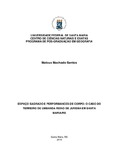| dc.creator | Santos, Mateus Machado | |
| dc.date.accessioned | 2020-01-14T14:32:49Z | |
| dc.date.available | 2020-01-14T14:32:49Z | |
| dc.date.issued | 2019-05-13 | |
| dc.identifier.uri | http://repositorio.ufsm.br/handle/1/19361 | |
| dc.description.abstract | The current research presents the results of a investigation of a Master Course accomplished at university federal de Santa Maria, UFSM/RS. The research focused on the epistemic field of cultural geography, more specifically in the geography of Religion. The premise was the understanding of the sacred space and the body performances in the Terreiro de Umbanda Reino de Jurema in the city of Santa Maria/RS. Its purpose was to investigate and problematize the Terreiro Reino de Jurema as a sacred space of umbanda as well as its performative meaning of body in the moment of the charitable sessions, inciting the relations between Researcher- researched in this study. The proposal of this investigation, from the chosen object, was designed from his experiences as medium in the own terreiro, ransoming interdisciplinary relations between the universe of arts and geography. we choose for a qualitative investigation, focused on the theoretical concepts of a participant observation and biographical(self) narratives. The methodological approaches were divided into three phases. the first step remembered the knowledge of the universe of the research theme. In the second and third stages theoretical and practical paths were recognized to think about how the production of sacred space and body performances were established, from the charitable sessions. The field observations in the terreiro Reino de Jurema were from September 2017 to November 2018.The data collection instruments performed in the second research stage, the main core of the research were: diary of field, photography record, videos and semi structured interview. In this context, seeking in the body a way of thinking the space, helped us to understand how the way the symbolic- religious thought was manifested through the ritualistic of Umbanda. that thought was reflected in a plural identity found in the terreiro Reino de Jurema. | eng |
| dc.language | por | por |
| dc.publisher | Universidade Federal de Santa Maria | por |
| dc.rights | Attribution-NonCommercial-NoDerivatives 4.0 International | * |
| dc.rights.uri | http://creativecommons.org/licenses/by-nc-nd/4.0/ | * |
| dc.subject | Geografia da religião | por |
| dc.subject | Cultura de umbanda | por |
| dc.subject | Espaço sagrado | por |
| dc.subject | Performances de corpo | por |
| dc.subject | Religion geography | eng |
| dc.subject | Culture of Umbanda | eng |
| dc.subject | Sacred space | eng |
| dc.subject | Body performances | eng |
| dc.title | Espaço sagrado e performances de corpo: o caso do Terreiro de Umbanda Reino de Jurema em Santa Maria/RS | por |
| dc.title.alternative | Sacred space and body performances: the case of the Umbanda Reino de Jurema in Santa Maria / RS | eng |
| dc.type | Dissertação | por |
| dc.description.resumo | A presente dissertação apresenta os resultados de uma pesquisa de mestrado realizada na Universidade Federal de Santa Maria, UFSM/RS. Essa pesquisa centrou-se no campo epistêmico da Geografia Cultural, mais especificamente na Geografia da Religião. Teve como premissa o entendimento do espaço sagrado e as performances de corpo no terreiro de umbanda Reino de Jurema na cidade de Santa Maria/RS. Seu objetivo foi investigar e problematizar o terreiro Reino de Jurema enquanto espaço sagrado de umbanda assim como sua significação performática de corpo no instante das sessões de caridade, fomentando as relações existentes entre pesquisador-pesquisado neste estudo. A proposta dessa investigação, a partir do objeto escolhido, foi traçado a partir de sua vivência enquanto médium no próprio terreiro, resgatando relações interdisciplinares entre o universo das artes e da geografia. Optou-se por uma investigação de cunho qualitativo, tendo como fundamento teórico conceitos da observação participante e narrativas (auto) biográficas. As abordagens metodológicas foram divididas em três etapas. A primeira etapa rememorou ao conhecimento do universo de conhecimento do tema da pesquisa. Já a segunda e a terceira etapas, apontou-se caminhos teóricos e práticos para pensar como se estabelece a produção do espaço sagado e as performances de corpo, a partir das sessões de caridade. As observações a campo no Reino de Jurema deram-se de setembro de 2017 até novembro de 2018. Os instrumentos de coleta de dados realizados na segunda etapa de investigação, cerne principal da pesquisa, foram: diário de campo, registro fotográfico, registro em filmagens e entrevista semiestruturada. Nesse contexto, buscar no corpo uma forma de pensar o espaço, ajudou-nos a compreender de que forma o pensamento simbólico-religioso, foi manifestado através das ritualísticas da umbanda. Tal pensamento refletiu-se numa identidade plural constatada no Reino de Jurema. | por |
| dc.contributor.advisor1 | Costa, Benhur Pinós da | |
| dc.contributor.advisor1Lattes | http://lattes.cnpq.br/6758952717155318 | por |
| dc.contributor.advisor-co1 | Nunes, Lúcia de Fátima Royes | |
| dc.contributor.advisor-co1Lattes | http://lattes.cnpq.br/9416062337546583 | por |
| dc.contributor.referee1 | Faria, Rivaldo Mauro de | |
| dc.contributor.referee1Lattes | http://lattes.cnpq.br/6024725847408179 | por |
| dc.contributor.referee2 | Rocha, Aristeu Castilhos da | |
| dc.contributor.referee2Lattes | http://lattes.cnpq.br/3178211577215938 | por |
| dc.creator.Lattes | Currículo lattes não encontrado. | por |
| dc.publisher.country | Brasil | por |
| dc.publisher.department | Geografia | por |
| dc.publisher.initials | UFSM | por |
| dc.publisher.program | Programa de Pós-Graduação em Geografia | por |
| dc.subject.cnpq | CNPQ::CIENCIAS HUMANAS::GEOGRAFIA | por |
| dc.publisher.unidade | Centro de Ciências Naturais e Exatas | por |



